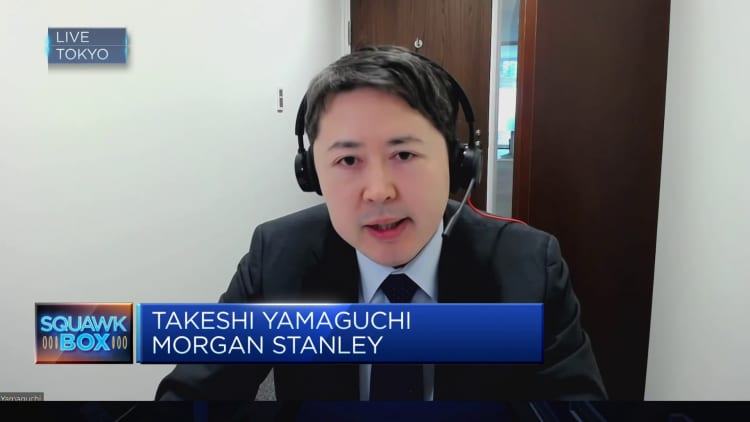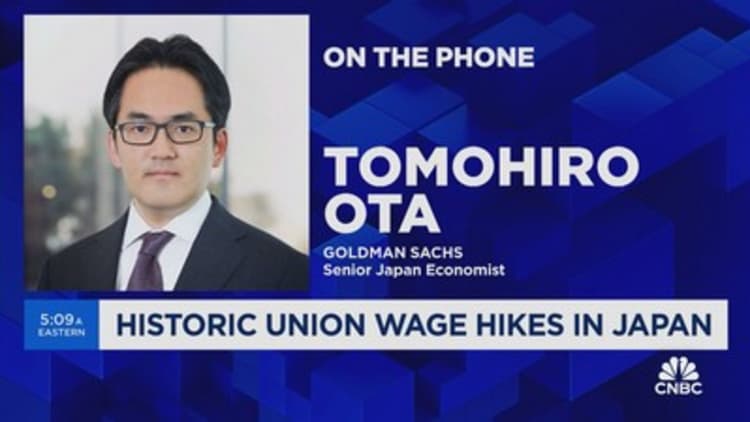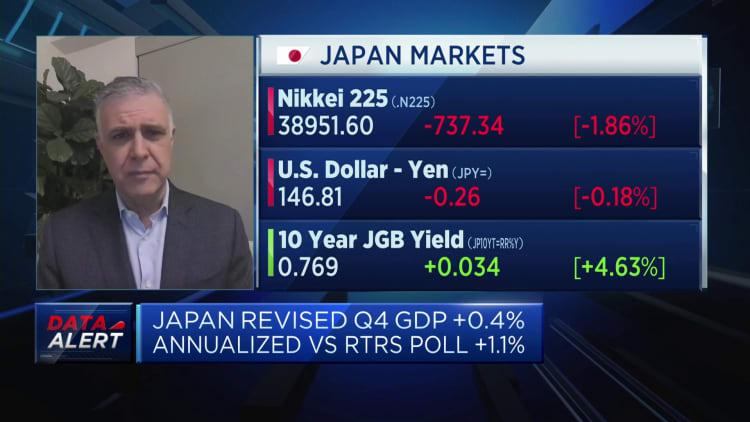Akihiko Matsuura, president of UA Zensen, second left, raises his fist with members of the union during a rally for the annual wage negotiations in Tokyo, Japan, on Thursday, March 7, 2024.
Kiyoshi Ota | Bloomberg | Getty Images
Japan’s largest trade union, Rengo, said Friday that workers at the country’s biggest firms are set for the sharpest wage spike in more than three decades, setting the stage for the central bank to exit the world’s last negative rates regime.
Rengo said its seven million members are poised to receive about 5.28% in salary increments in fiscal year 2024, according to the first of its several provisional updates for this year’s negotiations.
The world’s largest automaker Toyota on Wednesday agreed to the biggest annual pay increase for workers in 25 years.
Market speculation reached a fever pitch this week as various corporate giants announced robust salary increments, in some instances exceeding the unions’ demands.
There are expectations the Bank of Japan may hike rates for the first time since 2007 at its policy meeting next week, exiting negative rates.
Bank of Japan Governor Kazuo Ueda has repeatedly said the outcome of this year’s wage negotiations will influence the central bank’s decision on when to exit the world’s last negative interest rate policy.

Even though “core core inflation” — which excludes food and energy prices — has exceeded its 2% target for more than a year, the BOJ has barely budged from its current ultra-accommodative monetary policy posture that has been in place since 2016.
The BOJ’s thinking is that increased wages will stimulate consumer spending, lifting prices in a sustainable manner, and allowing more room for monetary tightening.
Here’s what you need to know about this year’s spring wage talks, which takes place annually in March.
What’s happened so far?
At the annual wage talks, management and unions of major companies across industries meet for negotiations to help determine employees’ pay and working conditions for the new fiscal year starting in April.
The bulk of the “shunto” talks concluded Wednesday, with many large Japanese companies such as automakers Honda Motor, Nissan Motor, and electronics producer Panasonic acceding to their unionized workers’ requests.

According to a Goldman Sachs tally of wage negotiations concluded so far, two of Japan’s largest steel companies agreed to large wage increases that exceeded union expectations — Nippon Steel agreed to 14.2% in wage increments, while Kobe Steel agreed to 12.8%.
Japan’s largest trade union grouping, also known as Rengo, said earlier this week workers at major Japanese firms have asked for annual increases of 5.85% — fanning hopes of a three decade-high wage increase.

This is far higher than the 2023 increase of more than 3%.
It marks a significant breakthrough in Japan, where real wages have stagnated since a banking crisis in the 1990s.
Why does it matter?
The Bank of Japan has pursued a policy of aggressive monetary easing in an attempt to stimulate prices after Japan fell into deflation and prolonged economic stagnation. However, the country has struggled to shake off attitudes surrounding stagnant wages.
Japan’s cultural focus on job security above higher pay is often blamed for stagnant wages.

Almost a third of Japan’s workforce was engaged in part-time employment — often seen as a drag on wages — in January, according to the latest data from the country’s Ministry of Health, Labor and Welfare.
Meanwhile, Japan’s headline inflation averaged 3.2% last year, but it slowed to 2.2% in January.
There have also been signs that the recent inflation has crimped domestic demand and private consumption in Japan.
Japan’s economy averted a technical recession last week, bolstered by strong capital expenditure. However, private consumption fell 0.3% quarter on quarter — more than the provisional estimate of a 0.2% decline.
What’s ahead?
While Japan’s large corporations have the capacity to accede to a wage bonanza given their record profits, all eyes will be on the small and medium businesses — which account for up to 70% of jobs in the world’s fourth-largest economy.
If major unions were able to get wage increases to about 5%, it would be enough to satisfy the BOJ that wages are rising and prompt them to shift monetary policy, Thierry Wizman, global interest rates and currencies strategist at Macquarie Group, told CNBC Monday.

Wizman said the change in policy would occur during the bank’s April meeting, but said that “risk has shifted to a March shift in policy.”
Meanwhile, Goldman Sachs economists led by Tomohiro Ota wrote in a Tuesday note that they still believe the BOJ will terminate negative interest rates in April.
“While a March rate hike cannot be ruled out, we believe that the BOJ’s communications at this juncture are not clear enough to justify assuming the March hike as the base case scenario,” they wrote.

